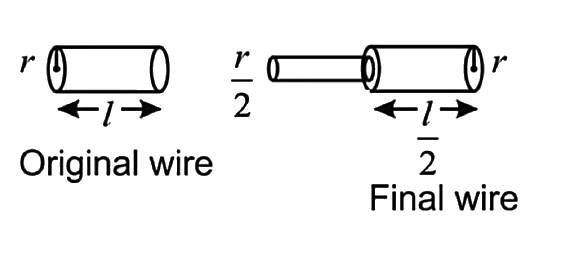Consider a wire of length l, area of cross section A, and resistivity ρ with resistance 10Ω. Its length is increased by applying a force, and it becomes four times of its original value. Find the changed resistance of the wire.
To find the changed resistance of the wire when its length is increased to four times its original value, we can follow these steps:
Step 1: Understand the formula for resistance
The resistance R of a wire is given by the formula:
R=ρLA
where:
- R = resistance
- ρ = resistivity of the material
- L = length of the wire
- A = area of cross-section of the wire
Step 2: Identify the initial conditions
We are given:
- Initial resistance R=10Ω
- Initial length L
- Initial area of cross-section A
- Resistivity ρ
Step 3: Determine the new length of the wire
The length of the wire is increased to four times its original length:
L′=4L
Step 4: Relate the change in length to the change in area
Since the volume of the wire remains constant, we have:
Volume=L×A=L′×A′
Substituting L′=4L:
L×A=4L×A′
From this, we can find the new area of cross-section A′:
A′=A4
Step 5: Calculate the new resistance
Substituting L′ and A′ into the resistance formula:
R′=ρL′A′=ρ(4L)A/4=4ρLA×4=16ρLA
Thus, we can express the new resistance R′ in terms of the original resistance R:
R′=16R
Step 6: Substitute the known value of R
Since R=10Ω:
R′=16×10Ω=160Ω
Final Answer
The changed resistance of the wire is:
R′=160Ω
---
The resistance R of a wire is given by the formula:
R=ρLA
where:
- R = resistance
- ρ = resistivity of the material
- L = length of the wire
- A = area of cross-section of the wire
We are given:
- Initial resistance R=10Ω
- Initial length L
- Initial area of cross-section A
- Resistivity ρ
The length of the wire is increased to four times its original length:
L′=4L
Since the volume of the wire remains constant, we have:
Volume=L×A=L′×A′
Substituting L′=4L:
L×A=4L×A′
From this, we can find the new area of cross-section A′:
A′=A4
Substituting L′ and A′ into the resistance formula:
R′=ρL′A′=ρ(4L)A/4=4ρLA×4=16ρLA
Thus, we can express the new resistance R′ in terms of the original resistance R:
R′=16R
Since R=10Ω:
R′=16×10Ω=160Ω
The changed resistance of the wire is:
R′=160Ω
Topper's Solved these Questions
- ELECTRIC CURRENT AND CIRCUITBOOK - CENGAGE PHYSICS ENGLISHCHAPTER - ELECTRIC CURRENT AND CIRCUITEXERCISE - Solved Examples
12 Videos
- ELECTRIC CURRENT AND CIRCUITBOOK - CENGAGE PHYSICS ENGLISHCHAPTER - ELECTRIC CURRENT AND CIRCUITEXERCISE - Exercise 5.1
28 Videos
- ELECTRIC CURRENT & CIRCUITSBOOK - CENGAGE PHYSICS ENGLISHCHAPTER - ELECTRIC CURRENT & CIRCUITSEXERCISE - Kirchhoff s law and simple circuits
15 Videos
- ELECTRIC FLUX AND GAUSS LAWBOOK - CENGAGE PHYSICS ENGLISHCHAPTER - ELECTRIC FLUX AND GAUSS LAWEXERCISE - MCQ s
38 Videos
Similar Questions
Consider a wire of length l , area of cross-section A and resistivity ρ and resistance 15Ω. Its length is increased by applying a force on I and its length increases by four times of its original length. Find the new resistance in ohms of the wire.
View SolutionA current i passes through a wire of length l , radius of cross-section r and resistivity ρ . The rate of heat generation is
View SolutionWhen the length and area of cross-section both are doubled, then its resistance
View SolutionIf a wire is stretched to four times its length, then the specific resistance of the wire will
View SolutionA resistance 10Ω is stretched to twice its original length . The resistance of the stretched wire is
View SolutionA wire of resistance 4Ω is stretched to twice its original length. The resistance of stretched wire would be
View SolutionThe resistance of a wire is 10Ω. Its length is increased by 10% by stretching. The new resistance will now be
View SolutionA wire of length l has a resistance R. If half of the length is stretched to make the radius half of its original value, then the final resistance of the wire is

View SolutionA wire of resistance 5Ω is uniformly stretched until its new length becomes 4 times the original length. Find its new resistance.
View SolutionA wire of resistance(10Ω) is stretched to twice its original length. The resistance of half of the streached wire is
View Solution
